The Treehouse-Inspired Airbnb At The Top Of Our Vacation Bucket List

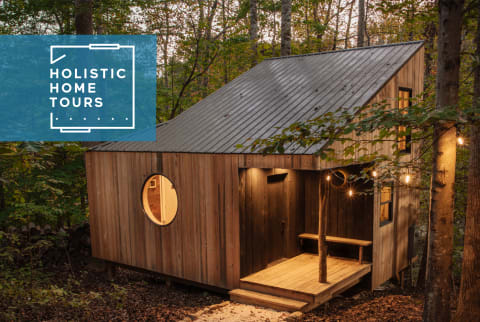
Nestled in the Swannanoa Valley, about 15 minutes east of Asheville, North Carolina, you'll find an Airbnb unlike any other. More than just a vacation rental, the Nook (@thenookavl on Instagram) is an invitation to a slower, more intentional way of living. Mike Belleme and his partner Kristin crafted the "obsessively handmade hyperlocal" space with the help of local artists, craftsmen, and nature. Nearly everything you see in the Nook is handmade, often from materials sourced from the surrounding woods. Here, Mike walks us through the tiny home in the trees and points out the details that make it so special.
What inspired you to start the Nook?
As a documentary photographer, I have spent many years working on personal projects having to do with living in more connection to the natural world and using your mind and body in a way that feels healthy and connects us to our deeper animal humanity—our humanity before we decided that we are something different and separate from everything else on Earth.

Exploring those themes led my wife Kristen and me to move to a treehouse outside of Asheville, to begin putting some of these ideas and skills into practice. The treehouse was deep in the woods; we had to hike in and out every time we left. The only heat source in winter was the woodstove. There were aspects of this new lifestyle that were not ideal (composting toilet for one), but it was a very impactful few years in our life. After a few years of semi-primitive living, we bought our current home. We're still in the woods, but now we have plumbing and the other typical aspects of modern life.
The Nook was heavily inspired by the treehouse and the teachings it offered us. The Nook is an art project first and foremost but also a way of letting area visitors get a glimpse of a different way of living and thinking. The Nook was a very collaborative project. We worked with over 20 local artists to hand-make every piece of the house, starting with our good friends Rob and Karie of Shelter Collective, who designed the space. Building the Nook took a year, wrapping up in the fall of 2019.
What are three words that describe the design philosophy at the Nook?
Connection, intention, hyperlocal.
The Nook clearly draws lots of visitors! What is it about the space that you think makes it so appealing to folks, especially these days?
Visitors may not fully understand all of the pieces that come together to tell a story here, but no matter what your entry point, there is something very different and almost jarring about seeing a space where everything was made by hand, slowly and intentionally. It's an act of rebellion in a world of immediacy, and people respond to that even if it's on a subconscious level.

There are several design elements intended to subconsciously guide the guest to a place of connection. Rather than pulling up and parking right next to the cabin, guests must take a short walk through the woods. The treehouse taught us that moving from one man-made environment (the car) directly to the next (a house) contributes to a sense of being dislocated from nature, that nature is something you schedule in your calendar and drive to. Letting the presence of trees mediate each transition to and from the house makes for distinct threshold moments. The walk through the woods quiets the mind and prompts you to notice your surroundings and be present.
The tea loft also is designed for intention rather than convenience. The guest, if they choose to use that space, is forced into a multi-step process that feels almost ceremonial. You must brew the tea in a French press, prepare the tea caddy, place it on the shelf, go up the ladder, and lift up the tea caddy. Investing effort, even when it's small, creates a level of intentionality and connection even if you don't realize it.
Basically, we indoctrinate our guests with a bit of our philosophy by forcing them to slow down and act with intention.
What object in the Nook brings you the most joy, and why?
That is very difficult to answer because each piece is born of relationships to both the people and land that I care so much about. Everything in that cabin is a piece of my heart and an ode to the people and landscape here.
Perhaps most of all, though, is the diorama that we commissioned Haley Nocik to make. Haley is a local (she has since moved away) fiber artist who uses felted wool to make incredible sculptural lifelike figures. I've always admired her work and decided to work with her on a piece for the Nook that told several stories about our animal neighbors.
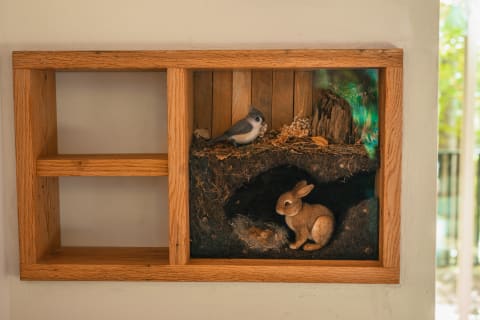
The diorama depicts two stories. When we were building the Nook and prepping for sheetrock, I found a bird's nest inside one of the walls. The nest was constructed not only of bits sourced from the forest floor but also from our building materials and wood shavings. I loved the meta-ness of this bird making its home in the home that we were making using our discarded bits. So I kept the nest and gave it to Haley to recreate a scene of the bird picking up our wood shavings.
The second story is when my friend and builder, Jesse, and I were walking down to the site and heard a squealing sound. Looking around, we saw a baby and mama bunny hopping away. I followed the sounds into a thicket where I found a black snake with a tiny baby bunny halfway down its throat. I extracted the bunny and relocated the snake. Later, I went back to the abandoned bunny burrow and saved the soft fur that the mother uses to make the nest cozy. I gave the fur to Haley, and she incorporated it into the scene with the bunny family hanging out in an underground burrow.
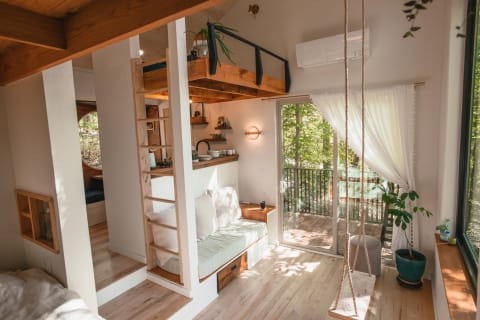
Can you tell me about the swing? So fun! What inspired you to put that in there, and where did you get it?
I think the swing was Kristen's idea. We wanted to find some way of accentuating the vertical space with the 18-foot ceiling, but most of all we wanted something whimsical that really spoke to the magic and unexpectedness of the space.
The swing is handmade from ash wood. I found the tree on the roadside in Asheville, took it to the sawmill, and used it for several things in the Nook.
All of the wood used in the interior is from wood that I gathered myself from already dead trees. Every tree species used in the house can be seen alive outside of the house immediately surrounding the Nook.
The decor is beautiful—where are most of the furniture/accessories from?
Almost everything is designed uniquely for the space and built by hand. No furniture was purchased. I partnered with friend and local woodworker Andy McFate on more complex builds like the ladders. The upholstery fabric for the couch, pillows, and the lofts was woven locally at Oriole Mill and sewn by our friends at Sew Co. The woven piece over the bed was created by Jessica of Rusted Earth. The stoneware and most of the kitchen accessories are from East Fork, an Asheville company that makes beautiful ceramics and also sells high-end handcrafted home goods. Like the Nook, they are sort of a collective that brings together tons of local creatives.
The main things that had to be purchased were light fixtures, appliances, plumbing fixtures, etc. In the rare instances where we had to buy non-local, it was mostly places like Anthropologie and West Elm.

What tips do you have for anyone who wants to bring a little bit of the Nook's calm, cabin aesthetic into their space?
Well, we are actually in the process of trying to do that in our own home now. Some things are very difficult to figure out after the fact when you aren't designing from the beginning, like having an abundance of natural light. I think light is the most important piece of what makes a space. Light quality, quantity, and temperature affect us deeply on a subconscious (and sometimes conscious) level. We are about to do a pretty multifaceted shift to the layout of our home with the primary goal of inviting in more light.
The more connected you feel to the space and objects in your home, the more it will feel like home and bring joy.
The other main thing is finding ways that you can feel personally connected to your space. Try making something yourself. Even if it's not the prettiest object, it will have more emotional resonance than anything you could get from a store. When you do buy, see if you can find someone local and watch their process, so you feel like you were part of it. The more connected you feel to the space and objects in your home, the more it will feel like home and bring joy.
What noises can be heard in the Nook? What smells are there?
The birds are very active around the Nook, so first and foremost you will hear the birds. If you get up very early, you will hear the "dawn chorus" when all of the birds announce the coming of the sun. In late summer the evening air is filled with the sounds of crickets. The squirrels are always making some kind of sound, whether they are gnawing on walnut shells or scurrying through the leaves.
Inside the Nook you might notice the smells of the local Elder & Co. candles, which are themselves inspired by the woods, national parks, and trails of Western NC containing essences of the conifers and herbs that can be found in these mountains. You may smell some of the aromatic woods, like oak, used in the house.
Outside, the cool air under the canopy has that impossible-to-describe "woodsy" smell, with the occasional pop of cherry from the wild cherry trees.
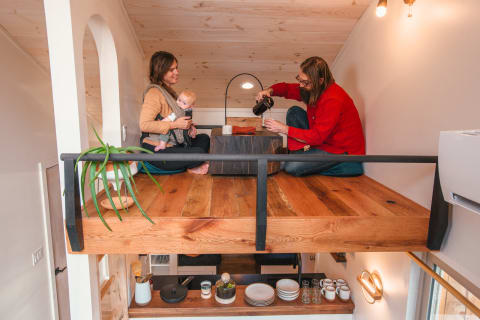
What is the best feedback you've ever received from Nook guests?
We have had guests express pretty profound and life-altering paradigm shifts through experiencing the Nook. Some have told us that it opened their eyes to a whole other way of thinking and being in the world and inspired them to harness that in their own home and life.
As I mentioned earlier, the project was intended as an art piece, so the guests' experience is a fundamental part of its purpose. Those rare transformative moments are really what the whole thing is about.
Recreate the look:
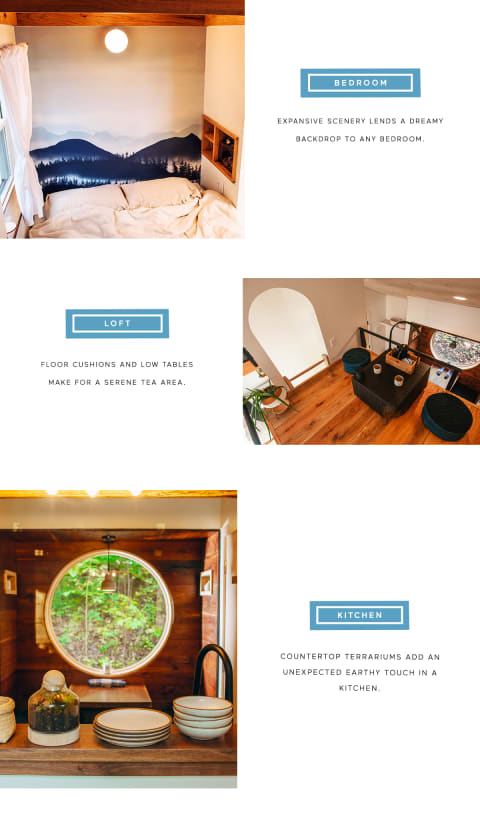

Emma Loewe is the Sustainability and Health Director at mindbodygreen and the author of Return to Nature: The New Science of How Natural Landscapes Restore Us. She is also the co-author of The Spirit Almanac: A Modern Guide To Ancient Self Care, which she wrote alongside Lindsay Kellner.
Emma received her B.A. in Environmental Science & Policy with a specialty in environmental communications from Duke University. In addition to penning over 1,000 mbg articles on topics from the water crisis in California to the rise of urban beekeeping, her work has appeared on Grist, Bloomberg News, Bustle, and Forbes. She's spoken about the intersection of self-care and sustainability on podcasts and live events alongside environmental thought leaders like Marci Zaroff, Gay Browne, and Summer Rayne Oakes.